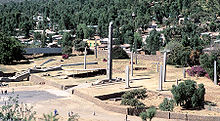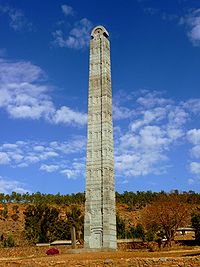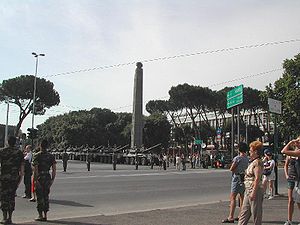- Obelisk of Axum
-
The Obelisk of Axum (today, especially in Axum, also called the Rome Stele) is a 1,700-year-old, 24-metres (78-foot) tall granite stele/obelisk, weighing 160 tonnes, in the city of Axum in Ethiopia. It is decorated with two false doors at the base, and decorations resembling windows on all sides. The "obelisk" ends in a semicircular top part, which used to be enclosed by metal frames.
Contents
History
The obelisk, properly termed "stele" or the native "hawilt/hawilti" (as they do not end in a pyramid), was carved and erected (with many other stelae) in the city of Axum (in modern-day Ethiopia), probably during the 4th century A.D. by subjects of the Kingdom of Aksum, an ancient Ethiopian civilization. Erection of stelae in Axum was a very old practice (today it is still possible to see primitive roughly carved stelae near more elaborated "obelisks"), probably borrowed from the kushitic kingdom of Meroe. Their function is supposed to be that of "markers" for underground burial chambers. The largest of the grave markers were for royal burial chambers and were decorated with multi-story false windows and false doors, while nobility would have smaller, less decorated ones. While there are only a few large ones standing, there are hundreds of smaller ones in various "stelae fields". The last stele erected in Axum was, likely, the so-called King Ezana's Stele, in the 4th century A.D.
King Ezana (c.321 – c. 360), indeed, helping the work of his childhood tutor Frumentius, introduced Christianity in Axum, precluding the pagan practice of erecting burial stelae (it seems that at the feet of each obelisk, together with the grave, there was present a sacrificial altar).
In the course of time, many of these stelae fell to the ground due to: structural collapse (as, likely, the case of the Great Stele, measuring 33 m), possibly immediately after their erection; earthquakes (Axum is in a seismical zone); or "iconoclastic" fury of islamic emir Ahmad Gragn, during Ethiopian-Adal War from 1529-43. This emir destroyed Axum, burnt churches and probably also ordered the destruction of the stelae. In 19th century, of the three major "royal" stelae, only King Ezana's Stele remained erected, as suggest the painting "Sight of Axum" of Henry Salt (1780–1827).
In particular, the today so-called Obelisk of Axum, collapsed and broke into three parts as a result of one of the three possible causes aforesaid. In these conditions, it was found by Italians soldiers at the end of 1935, after the Italian conquest of Ethiopia. In 1937, it was looted as prey of war and moved to Rome by the Fascist regime, which wanted to commemorate the conquest of Ethiopia and the birth of the ephemeral "new Roman empire" (see Italian Empire), which actually lasted for only 5 years (5 May 1936 marshal Badoglio entered Addis Ababa; 5 May 1941 Emperor Haile Selassie reentered Addis Ababa). The stele had fallen in the 4th Century and had broken into five pieces which were transported by truck along the tortuous route between Axum and Massawa (it took five trips over a period of two months) to the port of Massawa. It arrived via ship in Naples (on a boat called Adua), on March 27, 1937. Then it was transported to Rome, where it was reassembled and placed on October 28, 1937 in Porta Capena square, commemorating the 15th anniversary of the March on Rome, in front of the Ministry for Italian Africa (later the headquarters of the United Nations's Food and Agriculture Organization) and the Circus Maximus. These operations were coordinated by Ugo Monneret de Villard. Together with the obelisk of Axum, also arrived in Italy the bronze statue of the Lion of Judah, symbol of the Ethiopian monarchy, which was exposed in front of Termini railway station.
Its return to Ethiopia
In a 1947 UN agreement, Italy agreed to return the stele to Ethiopia, obviously with the other prey of war, the Lion of Judah. Instead of the latter, which was actually returned in 1967, after the 1961 visit of emperor Haile Selassie in Italy, little action was taken to return the stele for more than 50 years, also in consequence of the considerable technical difficulties related to such a transport. One source[1] also suggests that emperor Haile Sellassie, after hearing of these technical difficulties (and of the enormous costs necessary to overcome them), decided to grant the stele to the city of Rome, as a gift for the "renewed friendship" between Italy and Ethiopia. This assertion, however, remains very controversial and was not recognized by successive authorities. In 1972–73, Colonel Haile Mariam Mengistu asked the Italian government to return the stele to Ethiopia. Another controversial arrangement, according to some sources, seems to be that Italy could keep the stele in exchange for the construction of a hospital in Addis Ababa (Saint Paul's Hospital) and for the cancellation of debts owed by Ethiopia. In any case, after the fall of the Mengistu regime, the new Ethiopian government asked anew for the return of the stele, finding a positive answer from the then president of the Italian republic Oscar Luigi Scalfaro, in April 1997.
 The Northern Stelae Park in Axum, with the King Ezana's Stele at the centre and the Great Stele lying broken.
The Northern Stelae Park in Axum, with the King Ezana's Stele at the centre and the Great Stele lying broken.
The first steps in dismantling it were taken in November 2003, with the intent to ship the stele back to Ethiopia in March 2004. However, the repatriation project encountered a series of obstacles: the runway at Axum Airport was considered too short for a cargo plane carrying even one of the thirds into which the stele had been cut; the roads and bridges between Addis Ababa and Axum were thought to be not up to the task of road transport; and access through the nearby Eritrean port of Massawa – which was how the stele originally left Africa – was impossible due to the strained state of relations between Eritrea and Ethiopia.
Another reason for the delay in returning the stele from Italy to Ethiopia in 2004 was because of Italy's claim of not having the money to pay for the transportation.[citation needed] Attempt to get help from the United States was unsuccessful as Americans claimed that their planes were tied up in the war in Iraq.[citation needed] Numerous attempts by Professor Richard Pankhurst, who spearheaded the campaign to return the stele, remained unsuccessful until an American-Ethiopian[who?] threatened the Italian government with the option of raising the money on the Net.[citation needed]
The runway at Axum airport was then upgraded especially to facilitate the return of the stele. The dismantled stele remained sitting in a warehouse near Rome's Leonardo Da Vinci International Airport, until 19 April 2005 when the middle piece was repatriated by use of an Antonov An-124, amidst much local celebration. The second piece was returned on 22 April 2005, with the final piece returned on 25 April 2005. The stele remained in storage while Ethiopia decided how to reconstruct it without disturbing other ancient treasures still in the area (especially King Ezana's Stele). By March 2007 the foundation had been poured for the re-erection of the stele near King Ezana's Stele, structurally consolidated in this occasion. Reassembly began in June 2008, with a team chosen by UNESCO and led by engineer Giorgio Croci (who had also surveyed its dismantling in 2003) and the monument was resurrected in its original home and unveiled on 4 September 2008.[2]
When it was reassembled in 1937 three steel bars were inserted per section, however this caused the Obelisk to be hit and damaged by a thunderbolt during a violent thunderstorm over Rome, on 27 May 2002. In the new reconstruction the three sections are fixed together[3] by a total of eight aramid fiber (Kevlar) bars: four between the first and second and four between the second and third sections. This arrangement guarantees structural resistance during earthquakes and avoids the use of steel, so as not to again make the stele a magnet for lightning (and to avoid rust).
Several other similar stelae/obelisks exist in Ethiopia and Eritrea, such as the Hawulti in Metera. Like the Obelisk of Axum, the other stele have a rectangular base with a false door carved on one side.
See also
- Kingdom of Aksum
- Obelisks in Rome
Notes and references
- ^ For example, prince Amedeo di Savoia
- ^ BBC News; Ethiopia unveils ancient obelisk
- ^ Corriere della sera (in Italian);L’obelisco conteso rinasce ad Axum
External links
- Obelisks of Axum-North Ethiopia
- Obelisk arrives back in Ethiopia (BBC News)
- Ethiopia starts restoring obelisk (BBC News]
- The Axum Obelisk (Ethiopian Embassy in the UK)
- UNESCO says Axum obelisk to be put up before start of Ethiopian rainy season, People's Daily, 30 October 2005
Coordinates: 14°7′55.8″N 38°43′10.8″E / 14.132167°N 38.719667°E
Categories:- 4th-century architecture
- Axumite obelisks
- Obelisks in Rome
- Art and cultural repatriation
- Relocated buildings and structures
- Axum (city)
Wikimedia Foundation. 2010.


